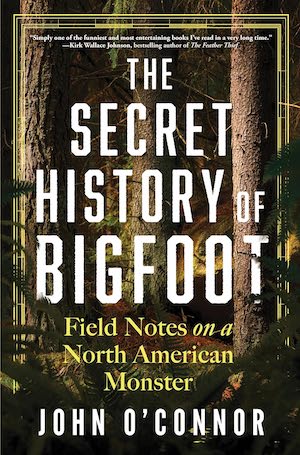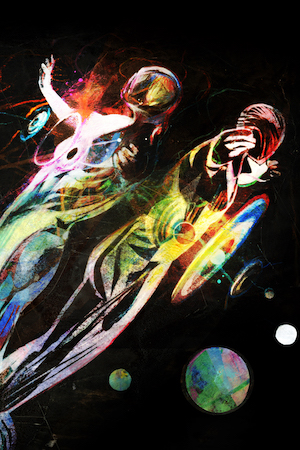John O’Connor’s book on Bigfoot, subtitled Field Notes on a North American Monster, is exactly what I’d hoped for when I pulled it out of the virtual pile of nonfiction Bigfootiana. It’s brand new, with a comprehensive bibliography, and it sums up its predecessors in sometimes exhaustive detail. It’s also a personal journey, which is often illuminating, not only for facts and figures but for insight into the author’s mind and motivations.
Every first-person account is essentially unreliable. That’s one of O’Connor’s themes. He’s no more immune to it than any of the Bigfoot hunters he met and interviewed and trekked through the wilderness with, and he’s generally honest about it.
Human memory, he reminds us, is subject to editing from the moment the memory forms. The further back in time it is, the more it’s revised, its details altered, its individual elements transformed by the witness’ expectations and biases. We all do it, no matter how hard we try to remain objective. We remember what we want to remember, or what others want us to remember, and we alter our memory of events to fit the desired pattern.
O’Connor’s book is not so much about the cryptid called, among many other things, Bigfoot, as about the humans who dedicate large parts of their lives to proving the creature exists. The world is full of stories of giant hairy apelike creatures, but O’Connor maintains that the epicenter of Bigfoot belief is North America, and specifically the United States. Although Bigfoot is not exclusively an American phenomenon, a certain subset of Americans have gone all-in on the concept.
Bigfooters, they call themselves. They get together for hunts. They have regional associations. They gather for conferences, complete with name badges and merch tables and celebrity guests. They’re numerous enough to support a notable television presence, including multiple seasons of Finding Bigfoot, from 2011 to 2018, and episodes of more general paranormal and monster series.
None of them, not even the hundred episodes of Finding Bigfoot, has ever found conclusive evidence. The videos have been debunked, the footprints explained away. There are no bones, no bodies.
And yet Bigfooters persist in their belief that somewhere out there, hidden in the wilderness, are viable populations of giant, hairy, malodorous, often noisy apelike creatures. Hundreds of people insist that they have seen Bigfoot—crossing the road, running up a mountainside, peering out of the deep woods.
Killer-monster movies notwithstanding, they’re not usually aggressive. Some of the lore associates their presence with feelings of intense fear, but they’ve seldom been accused of attacking humans. For the most part, they seem to just want to be left alone.
O’Connor proposes that Bigfoot doesn’t need to be an actual living creature. Most of the evidence of its existence can be ascribed to everything from bears to moose to raccoons. But that’s not what matters.
Bigfoot, he says, occupies an essential space in the American imagination. It’s an expression of a certain facet of the human psyche, the need to believe in something other than mundane reality. People want to believe, and what they believe in, in this case, is the archetypal Wild Man, the free spirit of the woods, unencumbered by the constrictions of civilization.
Cultures all over the world have told stories of a creature like this. What makes the modern American version unique, according to O’Connor, is the depth of Bigfooters’ belief. There’s an almost religious aspect to it, a deliberate choice of faith over facts (or lack thereof). And what they believe in is a certain kind of American ideal: the rugged individualist, the dweller in the forest primeval.
Bigfooters’ America is a specific cultural entity. It’s almost exclusively white, predominantly male, and has a distinct tilt toward the right side of the political spectrum. A significant proportion of Bigfooters have military or law-enforcement backgrounds.
White male journalist O’Connor, based in Boston and distinctly not conservative in his politics, manages to get along with the subjects of his study. He doesn’t get into any open conflicts, that he will admit to. (I’ll note here that O’Connor did try to investigate Native American traditions, without much success. He wasn’t welcomed into those communities.)
The Bigfooters he interviews and goes hunting and conferencing with seem to accept him without prejudice. They take him in, tell him their stories, share their food and camping equipment. Not all of them will let him publish their names, but they’re generous with their time and information.
They are everywhere in the United States. The Pacific Northwest, of course, which has one of the last remnants of old-growth forest, but California, too, and Texas, and Kentucky, and all the way up into New England. O’Connor has some very unflattering things to say about the northern end of the Appalachian Trail, and lays curses on the head of the man who designed it. O’Connor likes to complain, and professes not to be particularly outdoorsy, and yet he’s prone to intervals of solo and communal hiking in serious wilderness. Bigfooting isn’t all that alien a pursuit for him, insofar as he’s studying the hunters rather than the quarry.
Buy the Book


The Secret History of Bigfoot
One fairly lengthy section of the book goes off on what appears to be a tangent, but it ties in closely with O’Connor’s theme of persistent belief in a nonexistent creature. At one point he travels down to Arkansas in search of another kind of cryptid, a creature that actually existed but had been thought to be extinct: the ivory-billed woodpecker. I remember the breathless excitement in the news-sphere when it seemed that scientists had found a surviving population, and the controversy that followed.
The upshot, as O’Connor explains, is that the apparent sighting was a misidentification. The bird the first person saw was most likely another, still extant species, a pileated woodpecker, which in certain lights may resemble the ivory-bill. Subsequent sightings seem to have been manifestations of an all too human trait: people see what they expect to see. The ultimate decider, for O’Connor, was the expert who pointed out that ivory-bills left distinctive signs of their feeding behavior, and none of those has been found. The habitat has been destroyed; the bird is extinct.
O’Connor extrapolates from the bird to Bigfoot. People want to believe, but certain essential kinds of evidence have never been found. Bigfooters maintain that bodies in the deep forest disintegrate rapidly; that hunters can hunt bears or deer or birds and never actually see one; that Bigfoot is just very, very good at hiding.
And yet, again, an expert points out that regardless of how fast soft tissue may decay or be consumed by scavengers, bones persist for decades. Bones of known animals turn up all the time. The footprints are most likely bear tracks, if they’re not outright hoaxes. The videos are probably humans in monkey suits. None of it is real—except Bigfooters’ desire for it to be. The heart of it all is the human need to believe in something beyond themselves. We dream; we fantasize. We make up stories.
The Bigfoot story speaks to a certain segment of Americans. It manifests an ideal; it’s something to hold on to in a rapidly changing world. Maybe there is no Bigfoot. And yet—maybe. Maybe there is.









